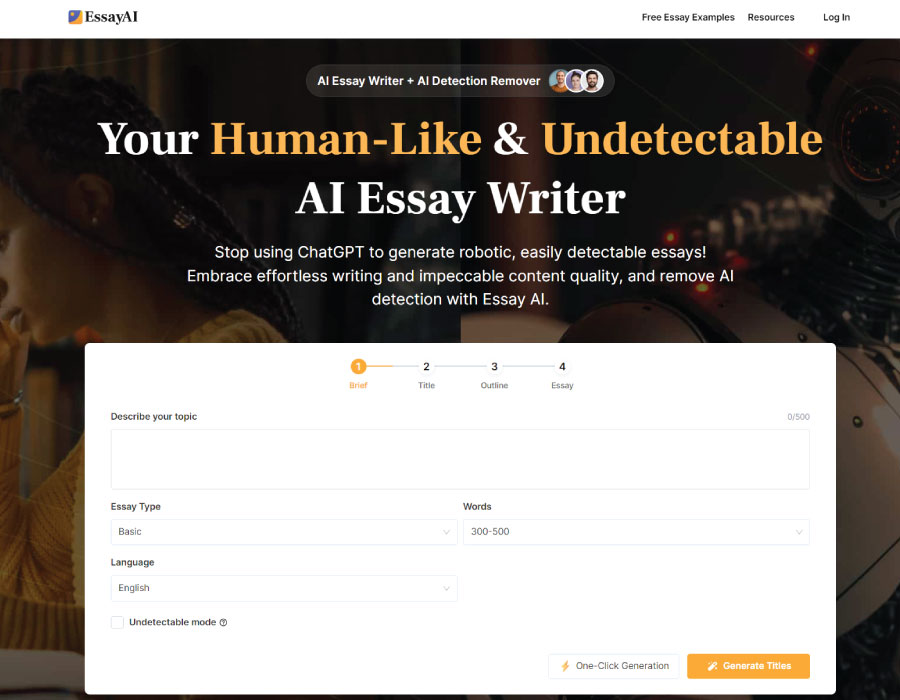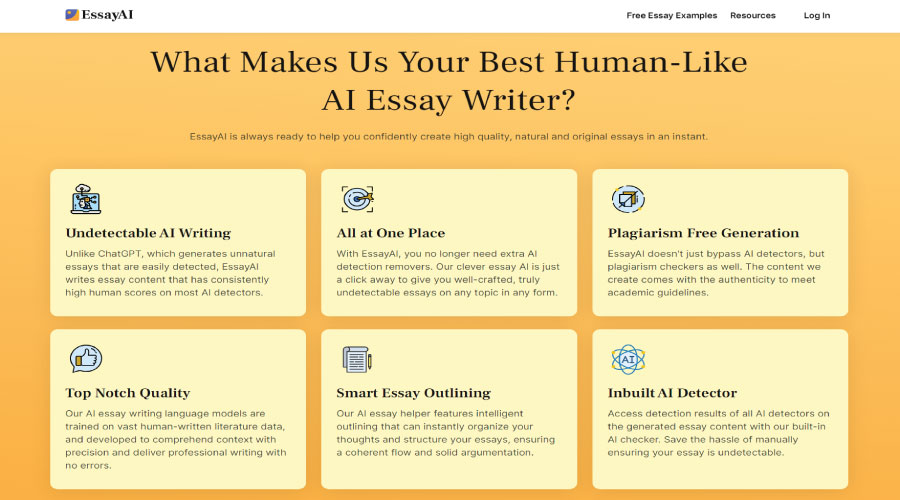In the realm of academic writing and beyond, technological advancements have paved the way for tools that could once only be imagined. EssayAI represents a significant leap forward in this evolution, positioning itself as a uniquely human-like AI essay writer. It appears to revolutionize the traditional essay writing process, promising to deliver content that not only bypasses AI detectors but also retains a high degree of originality and professionalism.
This comprehensive review will delve into the capabilities, features, and implications of utilizing EssayAI for various writing needs, assessing its claims to remove AI detection effectively and generate undetectable content across languages.

Understanding EssayAI's Unique Positioning
At its core, EssayAI markets itself as an undetectable AI essay writer, distinct from predecessors like ChatGPT. This revolutionary tool aims to solve a critical issue facing many writers today: the challenge of creating content that can bypass AI detectors without sacrificing quality. With a burgeoning need for plagiarism-free, original writings that adhere to academic and professional standards, EssayAI’s arrival is timely. But does it live up to its promises?
The Technology Behind EssayAI
The backbone of EssayAI is a large language model (LLM), specifically fabricated to outstrip the capabilities of existing AI essay writers by understanding and emulating nuances and depths of human writing. Trained with over 100 million high-quality, human-written essays, this LLM aims to produce content that is sophisticated, nuanced, and, most importantly, undetectable by AI detection tools such as Turnitin and GPTZero, among others.
A One-Stop Solution for Writing Needs
EssayAI positions itself as a one-stop solution, eliminating the need for additional AI detection removers or humanizing tools. This all-encompassing approach addresses a critical pain point for writers, offering a seamless, efficient pathway from inception to the final, polished essay. The promise is compelling: input your requirements, and receive plagiarism-free, high-quality, and undetectable content, ready for submission or publication.
Features That Set EssayAI Apart

- Undetectable AI Writing: A central feature of EssayAI is its ability to generate essays that consistently bypass AI detectors, portraying a human-like quality that is rare in AI-generated content.
- Plagiarism-Free Generation: Beyond its undetectable nature, EssayAI guarantees the creation of original content, addressing one of the most significant concerns in academic and professional writing.
- Advanced Smart Essay Outlining: The tool also provides intelligent outlining capabilities, aimed at organizing thoughts and structuring essays for coherent flow and solid argumentation.
- Integrated AI Checker: An inbuilt AI checker provides users with immediate feedback on the essay’s detectability status across various AI detectors, adding an extra layer of assurance.
Implications and Considerations
The introduction of EssayAI into the writing landscape brings both opportunities and considerations. For students, academics, and professionals, the tool promises to alleviate the pressures of essay writing, enabling a focus on research and ideation rather than the nuances of wording and structure. However, the ethical implications of undetectable AI-generated content in academic settings cannot be overlooked, prompting a discussion about the balance between technological advancement and academic integrity.
Potential Limitations and Areas for Improvement
While EssayAI’s offerings are impressive, the effectiveness of its AI detection bypassing capabilities and the true undetectability of its output remain to be seen in practical, long-term application. Furthermore, the richness and depth of content generated by AI are often influenced by the quality of input and the specificity of instructions provided by the user, suggesting a learning curve and a period of adaptation to maximize the tool’s potential.
Conclusion
EssayAI manifests as an ambitious endeavor to redefine AI-assisted writing, promising a suite of features designed to deliver high-quality, undetectable essays. With its advanced technology and user-centric features, it presents a compelling case for those looking to streamline their writing process while navigating the complexities of AI detection.
However, as with any tool of this nature, it invites users to engage with it responsibly, considering the broader implications of its use in academic and professional contexts. As the landscape of AI writing tools continues to evolve, EssayAI stands as a notable contender, pushing the boundaries of what AI can achieve in mimicking the intricacies of human writing.